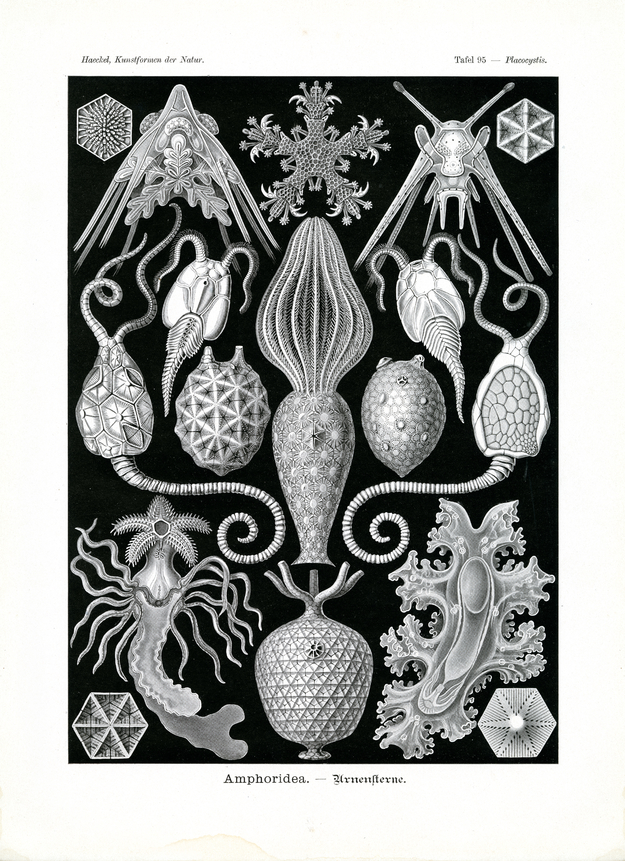Translation of the original German introduction by Ernst Haeckel:
Phylum of Echinoderma (Sterntiere); - main class of Monorchonia (Noncintes); - class of Amphoridea (Urnensterne).
The living ‘star-animals’ usually show a markedly five-radial body structure that distinguishes them at first sight from all other animals. An important exception, however, is the oldest class of Echinoderma, also called ‘case-stars’ (Amphoridea), separated from Cystoidea that were earlier understood in close affinity with them; they are found petrified in the oldest layers of Paleozoic formations, in Cambrian, Silurian and Devonial systems; during the ‘coal-period’ they died out. All Amphoridea lack the distinct Anthodium of the other ‘star animals’, i.e. the five-radial Ambulacral-rosette formed by the five ambulacrala or ‘sensing-plane’ surrounding the mouth. The oldest ‘case-stars’, Amphoralia (fig. 1-2), do not yet suggest the five-radial frame, rather resemble higher animals in their bilateral or bilateral-symmetrical body shape. In younger Amphoronia only (Fig. 5, 6) the Penataradial-radial structure begins with 5 to 15 arms [German text not clear] surrounding the mouth in corona-shape. Some of them bear close similarity with Stephanoceros, a tender form of rotifers illustrated on plate 32, fig. 5. Phylogenetically, too, Amphorideae have to be derived from similar bilateral Vermalia. Adaptation to sessile lifestyle has obviously caused the radial frame of the originally bilateral animals.
Our assumption that pentaradial Echinoderma originate from bilateral Vermalia is strongly supported in the ‘germ-history’ of the living ‘star-animals’. For the immature larvae during the early developmental stages that we call ‘Astro-larva’ (or Echinopaedia), still have a most simple body frame, similar to Rotatoria (‘wheel-animals’), and a purely bilateral basic shape; so Auricularia – larvae of Thuroidea (fig. 12; plate 50, fig. 3, 4); Plutellus – larvae of Echinidea (fig. 10); Pluteus – larvae of Ophiodea (fig. 9; plate 10, fig. 8); Bipinnaria – larvae of Asteridea (fig. 11; plate 40, fig. 3-6). During transformation only the pentaradial, sexually mature ‘star-animal’, Astrozoon, arises out of the bilateral ‘Astro-larva’.
Translation by VR Translators Bangalore
We've scanned the original lithography at 1200dpi on the Epson A3 scanner of A3 scanner huren. You can download a 400dpi JPEG here.
